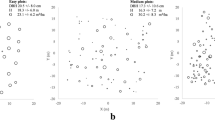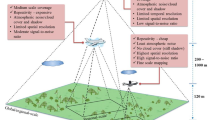Abstract
Low-cost lidar sensors mounted on unmanned aircraft systems (UAS) can be applied for the acquisition of small-scale forestry applications providing many advantages over airborne laser scanning (ALS), such as flexibility, low flight altitude and small laser footprint. Compared to 3D data generated from dense image matching using photogrammetry, lidar has the advantage of penetration through the canopy gaps, resulting in a better representation of the vertical structure of the vegetation. We analyse the effect of different flight altitudes on the penetration rate of heathland vegetation in the Blue Mountains, Australia using a Phoenix system based on a Velodyne Puck 16 scanner and a GreenValley LiAir X3-H system based on a Livox scanner. The different sensors achieve quite different performances, especially for the mid-vegetation layer between the canopy and the ground layer. Representation of this layer is especially important when investigating fuel availability for bushfire analyses. In this layer, the LiAir system achieves a sufficient picture at an altitude of 65 m above ground, whereas the Phoenix system needs to be flown as low as 40 m to get a comparable result.
This article was selected based on the results of a double-blind review of the full paper.
Supported by University of New South Wales.
Access this chapter
Tax calculation will be finalised at checkout
Purchases are for personal use only
Similar content being viewed by others
References
Aleksandrov M, Zlatanova S, Heslop DJ, Voxelisation and voxel management options in unity 3D X-4/W2-2022:13–20. https://doi.org/10.5194/isprs-annals-x-4-w2-2022-13-2022
Aleksandrov M, Zlatanova S, Heslop D (2021) Voxelisation algorithms and data structures: a review. Sensors 21(24):8241
Anderson WR, Cruz MG, Fernandes PM, McCaw L, Vega JA, Bradstock RA, Fogarty L, Gould J, McCarthy G, Marsden-Smedley JB (2015) A generic, empirical-based model for predicting rate of fire spread in shrublands. Int J Wildland Fire 24(4):443–460
Barton J, Gorte B, Eusuf MSRS, Zlatanova S (2020) A voxel-based method to estimate near-surface and elevated fuel from dense lidar point cloud for hazard reduction burning. ISPRS Ann Photogram Remote Sens Spatial Inf Sci VI-3/W1-2020:3–10. https://doi.org/10.5194/isprs-annals-vi-3-w1-2020-3-2020
Chapple RS, Ramp D, Bradstock RA, Kingsford RT, Merson JA, Auld TD, Fleming PJS, Mulley RC, Integrating science into management of ecosystems in the greater blue mountains 48(4):659–674. https://doi.org/10.1007/s00267-011-9721-5
Environment, D., Resources, N.: Overall Fuel Hazard Guide for South Australia, second edn
Eusuf, M.S.R.S., Barton, J., Gorte, B., Zlatanova, S.: Volume estimation of fuel load for hazard reduction burning: First results to a voxel approach. The International Archives of the Photogrammetry, Remote Sensing and Spatial Information Sciences XLIII-B3-2020, 1199–1206 (aug 2020). 10.5194/isprs-archives-xliii-b3-2020-1199-2020
Gorte, B.: Analysis of very large voxel datasets 119, 103316. 10.1016/j.jag.2023.103316
Gorte, B., Pfeifer, N.: Structuring laser-scanned trees using 3d mathematical morphology. vol. 35, pp. 929–933. Citeseer (2004)
Gould, J.S., McCaw, W., Cheney, N., Ellis, P., Knight, I., Sullivan, A.: Project Vesta: fire in dry eucalypt forest: fuel structure, fuel dynamics and fire behaviour. CSIRO Publishing (2008)
Hammill, K., Tasker, E.: vegetation, fire and climate change in the greater blue mountains world heritage area. techreport, https://www.environment.nsw.gov.au/-/media/OEH/Corporate-Site/Documents/Parks-reserves-and-protected-areas/Types-of-protected-areas/vegetation-fire-climate-change-greater-blue-mountains-world-heritage-area-100941.pdf
Hines, F., Hines, F., Tolhurst, K.G., Wilson, A.A., McCarthy, G.J.: Overall fuel hazard assessment guide, 4th edition. No. Report no. 82, Victorian Government, Department of Sustainability and Environment Melbourne (2010)
Hodgson ME, Bresnahan P (2004) Accuracy of airborne lidar-derived elevation. Photogrammetric Engineering Remote Sensing of Environment 70(3):331–339
Homainejad, N., Zlatanova, S., Pfeifer, N.: A voxel-based method for the three-dimensional modelling of heathland from lidar point clouds: First results V-3-2022, 697–704 (2022). 10.5194/isprs-annals-v-3-2022-697-2022
Homainejad, N., Zlatanova, S., Sepasgozar, S.M.E., Pfeifer, N.: Influence of voxel size and voxel connectivity on the 3D modelling of australian heathland parameters X-4/W2-2022, 113–119 (2022). 10.5194/isprs-annals-x-4-w2-2022-113-2022
Homainejad, N., Zlatanova, S., Pfeifer, N., Sepasgozar, S.M.E.: A methodology for an automated three-dimensional heathland assessment workflow in support of bushfire behaviour modelling. In: The 3rd Built Environment Research Forum. MDPI (mar 2022). 10.3390/environsciproc2021012024
Kelly, A.L., Franks, A.J., Eyre, T.J.: Assessing the assessors: Quantifying observer variation in vegetation and habitat assessment 12(2), 144–148. 10.1111/j.1442-8903.2011.00597.x
Lassiter, H.A., Whitley, T., Wilkinson, B., Abd-Elrahman, A.: Scan pattern characterization of velodyne VLP-16 lidar sensor for UAS laser scanning 20(24), 7351. 10.3390/s20247351
LIVOX: Specs, https://www.livoxtech.com/avia/specs
Meteorology, B.: New south wales in november 2020: very warm and dry, http://www.bom.gov.au
New South Wales, S., Department of Planning, I., Environment: Nsw state vegetation type map, https://datasets.seed.nsw.gov.au/dataset/nsw-state-vegetation-type-map
Otepka J, Ghuffar S, Waldhauser C, Hochreiter R, Pfeifer N (2013) Georeferenced point clouds: A survey of features and point cloud management. ISPRS International Journal of Geo-Information 2(4):1038–1065
New South Wales (Department of Planning, S., Environment): Heathlands | nsw environment, energy and science
Sikkink, P.G., Keane, R.E.: A comparison of five sampling techniques to estimate surface fuel loading in montane forests 17(3), 363. 10.1071/wf07003
Spits C, Wallace L, Reinke K (2017) Investigating surface and near-surface bushfire fuel attributes: A comparison between visual assessments and image-based point clouds. Journal of Sensors 17(4):910
Williams, R.J., Gill, A.M., Bradstock, R.A.: Flammable Australia Fire Regimes, Biodiversity and Ecosystems in a Changing World. CSIRO Publishing
Xu, H., Wang, C.C., Shen, X., Zlatanova, S.: Evaluating the performance of high level-of-detail tree models in microclimate simulation X-4/W3-2022, 277–284 (2022). 10.5194/isprs-annals-x-4-w3-2022-277-2022
Xu H, Wang CC, Shen X, Zlatanova S (2021) 3d tree reconstruction in support of urban microclimate simulation: A comprehensive literature review. Buildings 11(9):417
Author information
Authors and Affiliations
Corresponding author
Editor information
Editors and Affiliations
Rights and permissions
Copyright information
© 2024 The Author(s), under exclusive license to Springer Nature Switzerland AG
About this paper
Cite this paper
Homainejad, N., Winiwarter, L., Hollaus, M., Zlatanova, S., Pfeifer, N. (2024). Sensing Heathland Vegetation Structure from Unmanned Aircraft System Laser Scanner: Comparing Sensors and Flying Heights. In: Kolbe, T.H., Donaubauer, A., Beil, C. (eds) Recent Advances in 3D Geoinformation Science. 3DGeoInfo 2023. Lecture Notes in Geoinformation and Cartography. Springer, Cham. https://doi.org/10.1007/978-3-031-43699-4_19
Download citation
DOI: https://doi.org/10.1007/978-3-031-43699-4_19
Published:
Publisher Name: Springer, Cham
Print ISBN: 978-3-031-43698-7
Online ISBN: 978-3-031-43699-4
eBook Packages: Earth and Environmental ScienceEarth and Environmental Science (R0)




